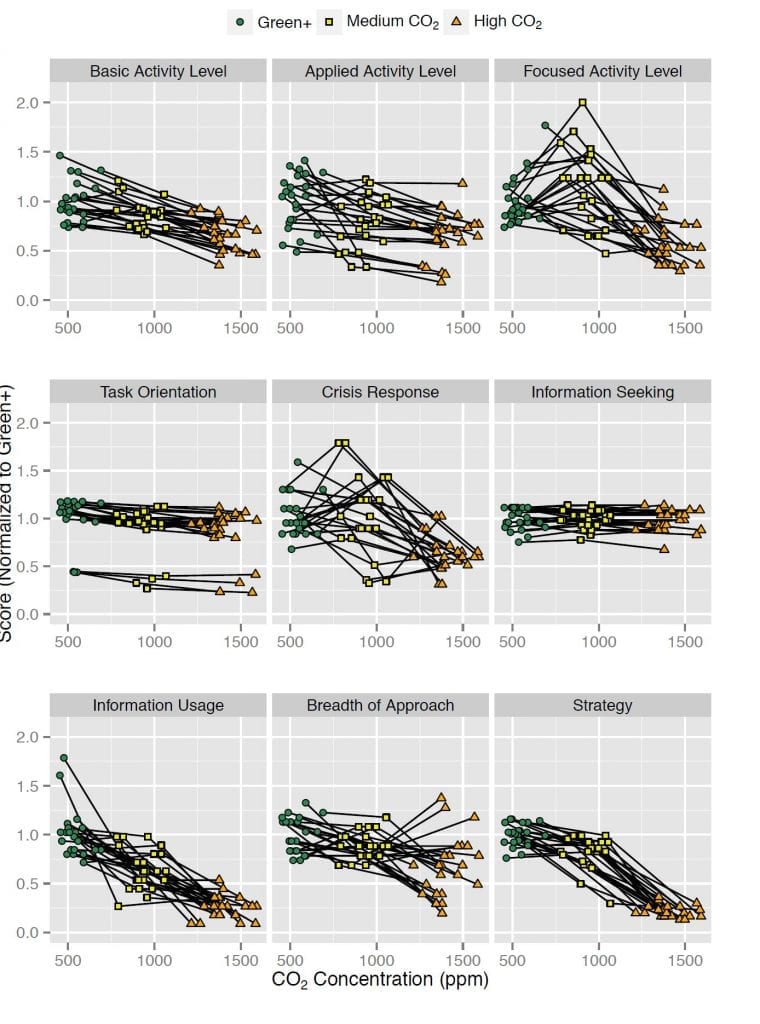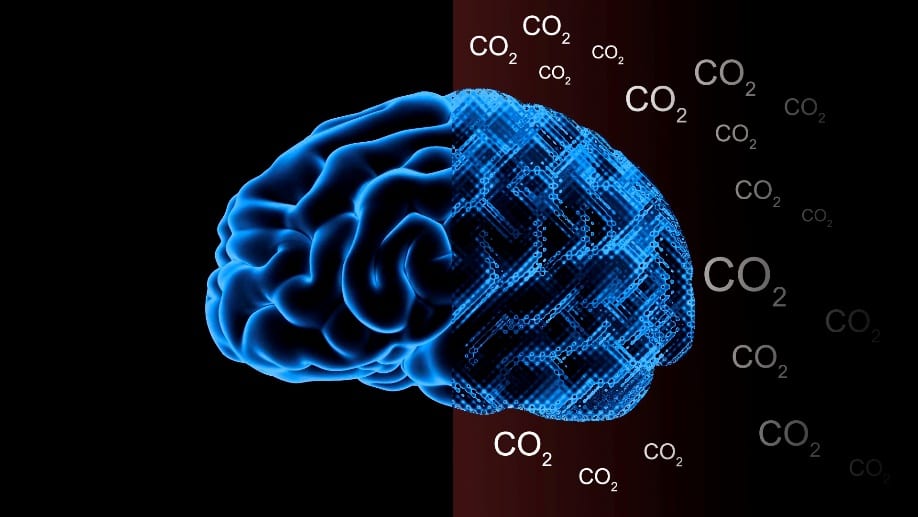
Save our brains from the destruction of cognitive functionality by excessive levels of CO2 in our living, working and travelling environments so we have enough brain power left to solve the climate problem driven by increasing concentrations of CO2 in our atmosphere. Graphic artwork courtesy of Chenxi Qian.
Do you think we have a serious greenhouse gas climate change problem caused by anthropogenic CO2 emissions in our atmosphere, which is threatening the future health and well-being of our civilization?
Well if you think that isn’t bad enough it seems that we also have to be seriously concerned about the impact of CO2 on the brain, which in a direct and negative way is impacting the cognitive and decision-making functions of humans at home and in our classrooms and workplaces. We are not talking here about the cause-and-effect of extraordinarily high levels of CO2 but rather concentrations that most of us would experience in closed poorly ventilated spaces on a day-to-day basis, when living, working and traveling respectively in our homes, classrooms, offices, planes, trains and cars.
I came across this information in a 2012 public health study from Lawrence Berkeley National Laboratory investigation [1] and a more recent 2015 public health study published by the Harvard T. H. Chan School of Public Health [2]. These two independent studies concur that statistically significant and meaningful reductions in decision-making performance, which could significantly affect productivity, learning and safety, are observable with increases in CO2 levels from 600 to 1000 to 2500 ppm. While these levels seem high in comparison to the 405 ppm CO2 currently recorded in our atmosphere, they are commonplace in poorly ventilated spaces of the kind mentioned above, where we spend large proportions of our time.

Figure 1. Cognitive function scores by domain and participant, and corresponding carbon dioxide concentration in their cubicle. Each line represents the change in an individual’s CO2 exposure and cognitive scores from one condition to the next, normalized by the average CO2 exposure across all participants during the Green+ conditions [2]. Reproduced with permission from Environmental Health Perspectives.
By inspecting results displayed in Figure 1, for nine double blind tests, for the dependence of cognitive function on the concentration of CO2, one is amazed to discover that average cognitive scores of typical participants, decreased by 21% with respect to 400 ppm increases in CO2 levels [2].
The adverse effects of high levels of CO2 are, of course, well-documented in for example, space travel, scuba-diving and submarines, aeroplanes and fire-fighting situations. However, the impact of greenhouse gas emissions on human health from living, working, playing and traveling in tightly sealed environments, is a disquieting surprise to many of us already worrying about the negative effects of greenhouse gas on our climate. While it is a truism that throughout our lives we make and exhale CO2 it is now apparent that we were not created to live in an atmosphere with increasingly high levels of CO2.
Isn’t it ironic that in our earnestness to create more energy efficient buildings with sustainable green designs to reduce levels of CO2 in our atmosphere and thereby ameliorate climate change, we have made more tightly sealed indoor environments, which increases the level of CO2 we breathe and can negatively affect our overall well-being? Building and ventilation codes that optimize conditions for human health and productivity are hopefully being vigorously evaluated.
How high can indoor levels of CO2 go? In a reported study, it was found that in a substantial number of poorly ventilated classrooms and workplaces, CO2 levels can average 1000 ppm, a significant proportion of these exceeded 2000 ppm and some even reached 3000 ppm. Keep in mind we are all currently living in an outdoor environment of 405 ppm with no sign that these levels will be abated for decades. In fact they are significantly higher in our cities. These levels are increasing at a rate of 2 ppm annually and the rate is accelerating. At some threshold yet to be defined but thought to be around a 1000 ppm, human cognition will begin to be negatively impacted. Latest research indicates we could attain this threshold outdoors in the next century, and the dissipation of CO2 in our atmosphere takes centuries.
So we have two looming health and safety problems to fret about, the negative effect of CO2 on our climate and also on our brains. In this context, two public health recommendations have emerged from these studies: (i) build better ventilation systems that use outside air in our buildings and transportation systems and (ii) decrease the use of fossil fuels to keep atmospheric levels below 600 ppm.
In this context I would anticipate that next generation aeroplanes will likely be employing CO2 sorbents, with standards established for spaceships and submarines, to solve this problem and soon these sorbents will be employed increasingly to control safe CO2 levels within a host of indoor environments. This is a task for the science and engineering of porous materials. Continued research and development to improve their CO2 sorption selectivity, capacity and stability, scalability and cost, provides new economic opportunities for clean-tech industries, wherever control of CO2 levels is deemed necessary for health and safety reasons.
It certainly seems that the risk of not doing anything is that “bad things” will begin to happen to the intellect, health and well-being of our entire civilization, if we let CO2 go beyond the 600 ppm threshold in our indoor and outdoor environments.
If we ever get into this dire circumstance, we may not have sufficient brain power left to solve the greenhouse gas problem which is beginning to play havoc with our climate.
References:
- Usha Satish, Mark J. Mendell, Krishnamurthy Shekhar, Toshifumi Hotchi, Douglas Sullivan, Siegfried Streufert, and William J. Fisk, Is CO2 an Indoor Pollutant? Direct Effects of Low-to-Moderate CO2 Concentrations on Human Decision-Making Performance, Environmental Health Perspectives, 2012, 120, 1671-1677.
- Joseph G. Allen, Piers MacNaughton, Usha Satish, Suresh Santanam, Jose Vallarino, and John D. Spengler, Associations of Cognitive Function Scores with Carbon Dioxide, Ventilation, and Volatile Organic Compound Exposures in Office Workers: A Controlled Exposure Study of Green and Conventional Office Environments, Environmental Health Perspectives, http://dx.doi.org/10.1289/ehp.1510037














